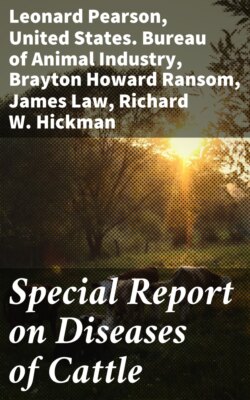Читать книгу Special Report on Diseases of Cattle - Lowe - Страница 30
На сайте Литреса книга снята с продажи.
DISTENTION OF RUMEN OR PAUNCH WITH FEED.
ОглавлениеThis form of indigestion is caused by the animal gorging itself with feed, and arises more from the animal's voracious appetite than from any defect in the quality of the feed supplied to it. The condition is, however, more severe if the feed consumed is especially concentrated or difficult of digestion. In cases of this kind there is comparatively no great formation of gas, and the gas which is formed is diffused through the stomach instead of accumulating in a layer in its upper part. On pressing the flank with the closed fist the indent of the hand remains for a short time in the flank, as if the rumen were filled with a soft, doughy mass.
This form of indigestion should be treated by stimulants, such as aromatic spirits of ammonia.
If the formation of gas is not great and the distention with solid material is somewhat limited, the animal may be drenched through a piece of ordinary garden hose, one end inserted in the mouth, and the other end fitted with a funnel, giving 1½ pounds of Epsom salt or Glauber's salt dissolved in 2 gallons of water, at a single dose. Immediately after this treatment the left side of the animal, extending below the median line of the abdomen, should be powerfully kneaded with the fist, so that the impacted food mass will be broken, allowing the water to separate it into small portions which can be carried downward for the process of digestion. But if the treatment fails and the impacted or overloaded condition of the rumen continues, it may become necessary to make an incision with a sharp, long-bladed knife in the left flank, commencing at the point where it is usual to puncture the stomach of an ox, and prolong the incision in a downward direction until it is long enough to admit the hand. When the point of the knife is thrust into the flank and the blade cuts downward, the wall of the stomach, the muscle, and the skin should all be cut through at the same time. Two assistants should hold the edges of the wound together so as to prevent any food from slipping between the flank and the wall of the stomach, and then the operator should remove two-third [sic] of the contents of the rumen. This having been done, the edges of the wound should be sponged with a little carbolized warm water, and, the lips of the wound in the rumen being turned inward, they should be brought together with catgut stitches. The wound penetrating the muscle and the skin may then be brought together by silk stitches, which should pass through the entire thickness of the muscle and should be about 1 inch apart. The wound should afterwards be dressed once a day with a lotion and the animal covered with a tight linen sheet, to protect the wound from insects and dirt. The lotion to be used in such case is made up as follows: Sulphate of zinc, 1 dram; carbolic acid, 2 drams; glycerin, 2 ounces; water, 14 ounces; mix. It is clear that this operation requires special skill and it should be attempted only by those who are competent.
